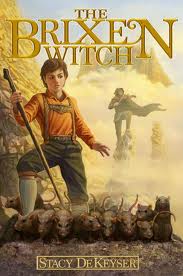 Review written by Jocelyn Koehler.
Review written by Jocelyn Koehler.
The premise of The Brixen Witch is easy. It takes “The Pied Piper of Hamelin” and puts some spin on it. “The Pied Piper” packs such a lot into its story that retelling it should be no problem. It’s an utterly compelling tale, with its unhappy ending, the lonely lame boy without playmates, and the mysterious justice of the Piper’s revenge. After all, he didn’t get rid of the kids until the mayor and town reneged on the promise of payment. And then there’s the curious historical grounding of the story. “The Pied Piper of Hamelin” is the only fairy tale I can think of that is tied to a particular real location, and hints at a real historical basis (whether the story is “true” or not is beside the point). There’s a lot to work with here.
DeKeyser, sadly, doesn’t work with any of that. She has no Hamelin in her world (which may not be the “real” world…she doesn’t say). Instead, this book takes place in Brixen (maybe this one?), hence the title. It’s a town of Germanic/Swissish bent nestled at the foot of a sorta-forbidden mountain. Forbidden why? Well, because a witch lives up there. Most folks are scared of her. It’s against the rules to talk about it…the first rule of Witch Club is don’t talk about Witch Club. So we’ve got the Pied Piper of Hamelin sans a Hamelin and plus a witch. Okay. Let’s get to the plot, shall we?
Our protagonist, Rudi, is up on the mountain hunting for rabbits when he stumbles across a gold coin. He pockets the amazing find (gold! free!) and hurries home, whereupon he soon realizes that it’s cursed and must belong to the witch. The witch wants it back and sends Rudi nightmares to drive the point home. He attempts to return it, but instead loses it just as winter comes, and endures a season of deprived sleep and night terrors until spring arrives, allowing him to go back up the mountain and start looking for the coin again. And that’s all in the first couple chapters.
The above bit explains the serious weaknesses of this book, which is that the story is so annoyingly episodic that reading it is a chore rather than a pleasure. The book is halfway over before the rats, and then the “piper” (who is actually a fiddler) show up. The rat problem (contrary to the sort of Chekov’s Gun promise of the back cover) gets resolved really quickly. And even the piper/fiddler situation ends up going sideways when it’s revealed that the witch turns out to be not Evil, the coin turns out to be a sort of Horcrux, and the Fiddler turns out to have a tragic flaw of greed. Cue the villagers, light the torches, and haul out the pitchforks. We’re going up the mountain to get our kids back! And they do. Everyone helps. The Fiddler is defeated, the witch gets her Horcruxes back, and all is well.
I can’t emphasize enough that while this book isn’t offensive or terrible in any way, it is not worth your time. Nothing about this story is special. The characters come straight out of Disney-approved Central Casting. The whole plot feels forced, like the author was under contract to get XX thousands words to her publisher by X date, and no one cared whether those words were particularly meaningful or added value to a well-worn legend.
SPOILER ALERT: Things you might want to know before suggesting this to your kid
Nothing, really. If you’re comfortable having your kids watch, say, animated Disney films of any era, there’s nothing in here that will contradict those values.
But specifics…
Family and Friendship
It’s mostly good. Rudi’s parents are kind of clueless (and he doesn’t clue them in), but his grandmother, or Oma, is hyperaware of all his problems and offers wise grandmotherly advice on how to solve the various issues.
Magic
It’s presented as something to be avoided, if not feared. The book seems to take place in a fantasy world, rather than a historical-plus Europe. The witch is a more-than-human figure, as is the Fiddler, and they both are shown as rather foreign entities that must be handled carefully. Magic isn’t portrayed as evil, although the witch is suggested to be cranky-to-capriously-hexy by most of the villagers, and the Fiddler is straight-up Bad.
Gender Roles
Rudi, a young boy, is undoubtedly the hero, and the Fiddler is the ultimate antagonist. The two old ladies (Oma and the witch) both serve supporting (but significant) roles. And the little girl who is used at several points to help propel the plot by telling Rudi things never becomes more than that. She exists to help Rudi and to idolize him in a safe way. I don’t want to read too much into this, because I don’t think its intentional or particularly damaging, but…could be better.
Recommendation
Short version: Read something else.
Long version: If you want a tale of medieval Euros opposing occult evil on a mountainside, I direct you to Philip Reeve’s No Such Thing As Dragons (Read my review of it, too.). If you want a smart, touching, and truly innovative twist on the Pied Piper tale, I direct you to Terry Prachett’s The Amazing Maurice and His Educated Rodents
, which literally made the world look funny to me for a couple of days after reading it…and that is the highest praise I can offer regarding a book. The Brixen Witch offers no such gift. Is it terrible? No. But it’s also not great. And life is too short for not-great books.
The Brixen Witch by Stacy DeKeyser
Published in 2012 by Simon & Schuster, Margaret K. McElderry Books (imprint)
Read free ARC





Speak Your Mind